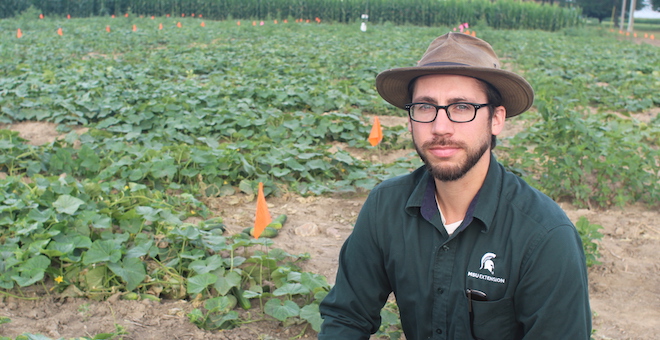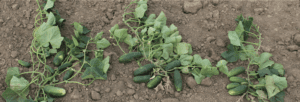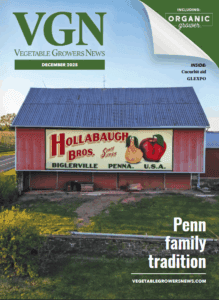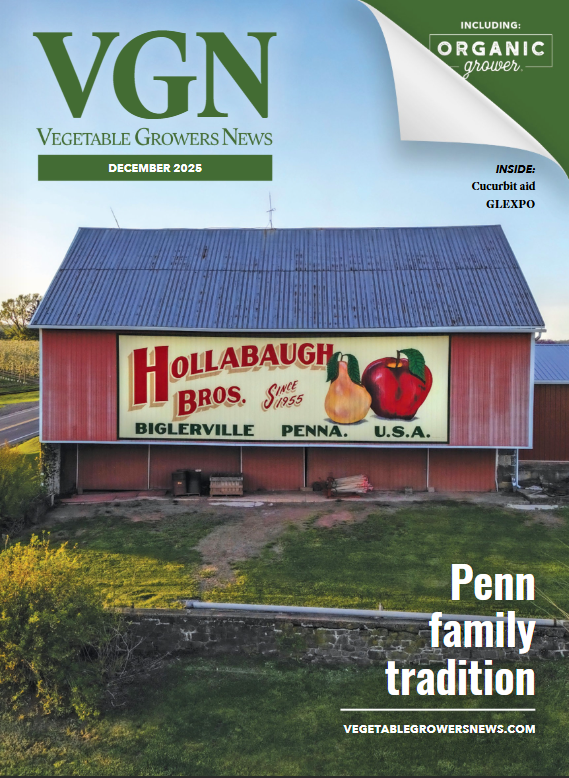
Nov 24, 2020Briner, grower needs drive seedless cucumber moves
Michigan’s 25,000 acres of cucumbers makes it the leading producer of cucumbers in the country. Brining for pickle production is the big market. Mechanical harvesting predominates and the industry is now exploring seedless varieties.
To lend some insight into those changes, Vegetable Growers News reached out to Ben Phillips, Michigan State University (MSU) Extension vegetable educator, to discuss the subject. Phillips conducts yield trials on seedless cucumbers and is based in the Bay Region of eastern Michigan which is prime ground for growing pickling cucumbers.
Vegetable Growers News: How is the plant architecture of seedless varieties different from conventional varieties?
Ben Phillips: Plant architecture has been going through a few different phases. Older varieties have long vines, multiple vines and flowers all along the length of them. Plant breeders have been breeding to shorten the vines and have more fruit close to the crown. The seedless pickle varieties I harvest – called parthenocarpic varieties – mostly have one vine, set their fruit near the crown of the plant, and it’s easy to tell when it’s time to pick.
The big advantage is that with a concentration of flowers, you get fruit that’s all about the same size. You get all of the fruit around one crown. They’re all about the same. That’s the gold crown of mechanical harvesting.
VGN: What other advantages do seedless varieties have?
BP: From the perspective of a grower, seedless varieties have the potential to yield higher and have a more concentrated fruit set. Along with higher yield you get more fruit of the proper shape – fewer are misshapen – and you get fewer culls which again improves yield. Seedless varieties don’t require bees so there are savings in not having the expense of a beekeeper and having to move bees around. They also don’t have the risk of poor conditions for fertilization. On cold days, partially pollenated cucumbers wind up misshapen and pointy. Seedless varieties also have a thicker skin and that works better in mechanical harvesting.
Briners are attracted to the idea of fewer internal defects when the pickles are cut. With seedless varieties, not encountering seed during cutting makes it easier to control their shape.
There are a few disadvantages. The tough skin that growers like sometimes is a challenge for briners. The brine doesn’t soak through the skin and you have a whole vat of cucumbers that spoils because they don’t get preserved. There’s a balance to achieve in skin thickness.
Seedless varieties have about 30,000 plants per acre and that’s about half of what you want to plant conventionally. But with more expensive seed, it takes about 250 bushels per acre to break even with seedless varieties. It takes about 200 bushels of pickles per acre to break even with standard varieties.
The yield potential of seedless varieties is upwards of 600 bushels per acre in som plantings in some years with some varieties. For example, an early June planting of Gershwin in 2020 may yield between 600 and 650 bushels, but a July planting may not. Like every crop, each year is different, too. Standard varieties tend to max out in the 500-bushel range.
VGN: How should growers select their varieties?
BP: Briners are the main source of information. Most commercial pickle growers get a short list of varieties from their briner. Briners do a lot of research with data from several states and talk to seed companies who have access to more information about their varieties.
From that list, for growers, it then becomes yield potential, price per thousand seeds, and days to maturity. Price for seedless varieties averages about $12 per thousand seeds, versus about $5 per thousand for a standard-seeded variety. Most pickles can be harvested in 40 to 50 days. Growers want varieties that can be planted – and then be harvested – at different times.
Seedless varieties tend to be slower in gaining size so you don’t have to scramble around after a rain event trying to harvest cucumbers before they get too big. Seeded varieties will get really fat very quickly after a rain event.
Some growers plant both standard and seedless varieties to manage risk. You still have issues with needing bees for the standard varieties, and then there’s the issue of spreading them out – isolating fields of different types – so you don’t get pollination in seedless varieties.
I’d say growers should work with the briner’s short list but also talk to seed companies, and review our trial data. Some seed companies may have more data for your area than what we have, and can share information on pre-commercial varieties at their discretion. We’re not allowed to share all data of all varieties due to trial agreements protecting the privacy of their pre-commercial material.
There are four main seed companies for cucumbers. Rijk Zwaan is the title holder for seedless varieties and has the most varieties available for mechanical harvest. Nunhems has been in seedless cucumbers for a while, too, and has a few varieties in the pipeline. Bejo is a relative newcomer to this market. Bejo has had hand-picked varieties in Europe and the U.S. and has moved into pickle varieties for mechanical harvest.
Seminis pretty much has the lion’s share of the standard pickling varieties but is getting close to releasing some seedless ones.

VGN: Yield trials are important when evaluating cucumber varieties grown for pickling. Why are brining comparisons also important?
BP: The types of things growers like aren’t always what briners and customers like, and everyone’s view needs considered. Growers like yield; that’s more dollars. Briners like something that has a very consistent size and shape, and that doesn’t bloat in the brining tank. A bloater is a pickle that traps gas internally during the brining process and its insides all turn to mush. That’s why you also have to evaluate varieties in the vat tank – to identify those prone to bloating. The thicker skin growers like can equate to skin toughness for the briner and inadequate pickling. That leads to large losses at the briner. Varieties must be evaluated on whether their thicker skin leads to inadequate pickling.
Length and diameter are also important to briners. In our trials, we measure the fruit end to end and side to side, and divide length by diameter to get the L/D ratio. Most briners are looking for measurements of 3 to 3.2. That makes for a good spear that fits into a jar. If you get to 3.2, you get more slices to cut for sliced pickles.
Some varieties just don’t put the length on in certain conditions – like during hot spells – and that’s something briners look at when making their short list for growers.
The selection process starts with the briner. Find what brines well, then of those, what have good yield and desirable maturation times? Selection needs to strike a balance between what the briners need
and what the growers want. In this part of Michigan, there are many growers and many briners. That makes this a good location to do this kind of research.
VGN: Should only varieties with tolerance to downy mildew be considered?
BP: Downy mildew was managed with varietal resistance until 2012 and then the pathogen overcame the resistance. It’s taken close to a decade for new, tolerant varieties to come out. Downy mildew-tolerant varieties help but downy mildew can overcome them. Growers have to spray anyway, so many are sticking with the older varieties they’re familiar with – knowing they’ll have to spray You have to learn the varieties you use – learn how they grow and size up across a couple plantings and seasons. Most growers are sticking with the varieties they know.
VGN: Isn’t scouting and predicting downy mildew outbreaks getting better?
BP: We can put up traps for the spores and know when it’s around. Growers will tell the right people when they’ve found it, who can spread the word for the good of the whole. That makes it easier to know when an outbreak has blown in. We watch for it and when we find it, we sound the alarm. That system has been worked out pretty well.
VGN: How do you ensure you’re selecting a variety that’s the best match for your market?
BP: If you’re a grower, your market is the briner. You’re working for them. You look at their short list and then have to decide what works best on your farm and in your situation. Briners will be after brining characteristics. If you’re a grower, you’re looking at yield, price and days of maturity. You already know you’ll be planting a variety that brines well and then it becomes what grows well for you.
VGN note: Phillips’ yield data from MSU’s seedless cucumber variety trials can be found on the Midwest Vegetable Variety Reports website. The site is maintained by Purdue University and the 2019 data can be found at: https://ag.purdue.edu/hla/fruitveg/Pages/MVVTRB.aspx
— Dean Peterson, VGN correspondent
















